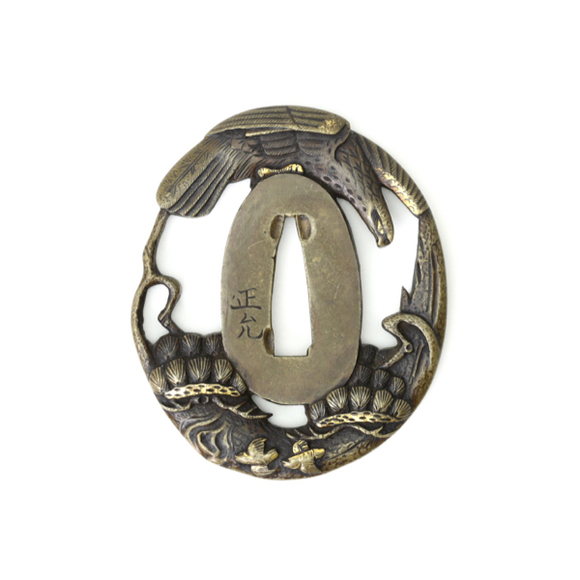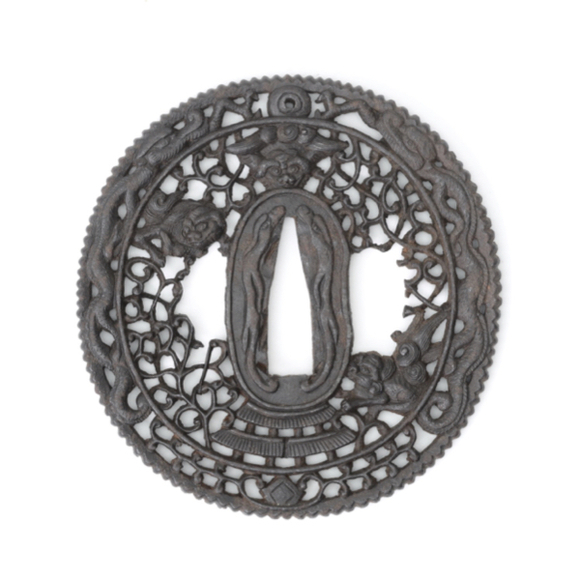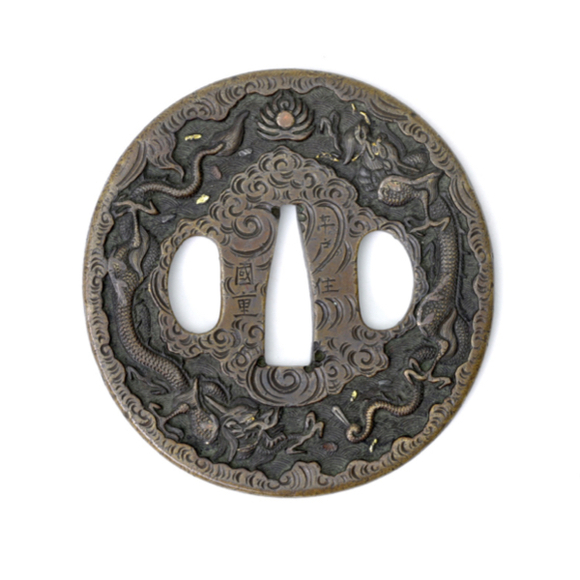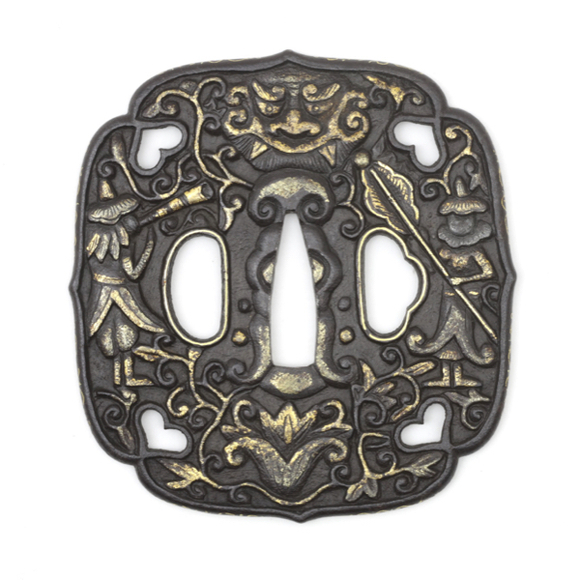Russet iron, one-piece construction with decorative grooves.

87.8 cm
49.7 cm
38 cm
Base 8 mm
Start backedge 8 mm
Kissaki 6.5
691 grams
Blade: steel
Habaki: copper, gold
Owari, Japan
Made between 1592 - 1607 A.D.
Masatsune
Introduction
The naginata (薙刀) is a Japanese polearm with a curved, slicing blade. They were used among others by the samurai and their infantry. But more famously by sōhei (僧兵) warrior monks, and the onna-musha, a female warrior class of the Japanese nobility.
"If asked who was the most skilled maker of naginata throughout the Shinto and Koto periods, Sagami no Kami Masatsune is such a master that his name would be cited first at the head of some 10,000 others.
The naginata of the Shinto period have a broadly swelling point, and the saki-zori is extremely intense creating a brusquely unrefined shape. However, the shape of Masatsune's naginata resemble the old style shapes of the Kamakura period. Moreover, his shapes unite magnificence with great power."
-Kentaro Yoshikawa
Founder of the NTHK and former caretaker of the imperial collection
(Published in Art and the Sword, Volume 2. 1988.)
Sagami no Kami Masatsune (相模守政常)
Real name Nando Tarōsuke (1535-1619), he was born in Mino as the second son of the 9th generation Suke ́emon Kanetsune.1 His life unfolded during a pivotal time in Japanese history when powerful factions fought over supremacy in a bloody civil war known as the Sengoku period (1477 - 1573). He was a contemporary of the three great unifiers of Japan; Oda Nobunaga (1534-1582), Toyotomi Hideyoshi (1537-1598), and Tokugawa Ieyasu (1543-1616).
In 1567 he established his own branch of his father's Kanetsune line in Komaki village, Mino, during which time he signed Kanetsune on his blade tangs. He later moved to work in Kiyosu in Owari, where he he changed his name to Masatsune. Owari was the birthplace of both Oda Nobunaga and Hideyoshi and the former's seat of power. Nobunaga was assassinated in 1582.
In 1590, imperial regent Toyotomi Hidetsugu, took over the fief and employed Masatsune. Hidetsugu was imperial regent, Hideyoshi's appointed successor. He handled state affairs when Hideyoshi was campaigning in Korea between 1592-1598.
Masatsune was granted the full title Sagami no Kami Masatsune (相模守政常), "Lord of Sagami; Masatsune" in 1592 by the agency of Hidetsugu who received him at his residence in Kyoto a year prior.
In 1595 daimyō Fukushima Masanori (1561-1624) took over the fief and its Kiyosu castle and employed Masatsune. He single-handedly put this province on the map when it comes to swordsmithing. He was part of the so-called "Owari-sansaku“ (尾張三作), the "Three Owari Masters", together with Ujifusa and Hoki No Kami Nobutaka. He is considered the best of these three.2
Fukushima Masanori
Fukushima Masanori was one of Hideyoshi's most trusted samurai. When he hired our smith, he lived in Kiyosu Castle, the former residence of no less than Oda Nobunaga himself, the first unifier of Japan. Masatsune and Teruhiro made many fine naginata during this period, which are thought to have been used by his castle guards.

Ukiyo-e of Fukushima Masanori
Tokyo Metropolitan Library
Masanori was one of the "Seven Spears of Shizugatake"; mounted bodyguards for Hideyoshi at the battle of Shizugatake in 1583. In the heat of the battle, Hideyoshi ordered them to charge at the opposing army of Shibata Katsuie. Masanori took the first head, that of general Ogasato Ieyoshi. The attack lead to a sure victory for Hideyoshi, who through this battle asserted his position as the successor of Oda Nobunaga as ruler of Japan.
Masanori also took part in Hideyoshi's Korean campaign and took the city of Ch'ongju in 1592. Masanori was, at some point, the owner of the Nihongo (日本号), one of the Three Great Spears of Japan, now in the Fukuoka City Museum.
Hideyoshi's concubine unexpectedly bore him a son, which led to tensions between Hideyoshi and his nephew Hidetsugu who was originally pointed as his successor. In 1595 Hideyoshi accused Hidetsugu of plotting a coup and sent Masanori for Hidetsugu, leading 10.000 men. He forced Hidetsugu to commit seppuku. In an unusual act of cruelty, Hideyoshi then ordered the massacre of Hidetsugu's entire family in Kyoto, including 39 women and children. The victims even included the daughter of a powerful daimyō that was destined to marry Hidetsugu but had not even met him yet.
This act alienated many daimyō from Hideyoshi, and at the battle of Sekigahara in 1600, two years after Hideyoshi's death, Masanori and five others of the Seven Spears betrayed Hideyoshi's son Hideyori by siding with Tokugawa Ieyasu's Eastern Army. Ieyasu was to become the victor, consolidating Tokugawa rule, ending the Sengoku period, and hailing in the peaceful Edo period which would last until 1867.
Work under Matsudaira Tadayoshi and retirement
After the battle, Ieyasu granted Hiroshima castle and its fief to Fukushima Masanori. Our smith Masatsune remained in Kiyosu and was employed by Matsudaira Tadayoshi (1580- 1607), 4th son of Tokugawa Ieyasu, who took over this fief. After Tadayoshi's sudden death in 1607 Masatsune briefly retired, but his son and successor, Tarōsuke, passed away in 1609, after which Masatsune once again picked up the hammer.
From this time onwards, he added Nyūdō (入道) to his signature indicating he had now become a lay priest. He passed away in 1619 at 84 years of age, but his lineage would continue for ten generations.2
Only the first two generations signed with Sagami no Kami Masatsune (相模守政常) but works of the 2nd generation are extremely rare. The third generation exchanged the Sagami no Kami title for that of Mino, signing "Mino no Kami Fujiwara Masatsune” (美濃守藤原政常).3
Notes
1. Dr. Honma Junji; Nihon Shinto Shi (The History of the shintō Era of Japanese Swords). Translation by Markus Sesko. Lulu, Inc. 2013. And Nihon to Koza, Vol 4, Shinto. Page 154-155. Also see Kentaro Yoshikawa; The Swords of Owari, published in Art and the Sword, Vol II, 1989.
2. Markus Sesko; Swordsmiths of Japan. Lulu, Inc. 2014. Pages 598-599. Also see: Tanobe Michihiro; Sagami no Kami Masatsune, Token Bijutsu, Vol 2. Pages 111-116.
3. Nihon to Koza, Vol 4, Shinto. Page 155.
Work style and ratings
A very versatile smith, he made all the common blades of the time: katana, wakizashi, tantō, yari, and naginata. Tantō and hirazukuri wakizashi are the most common.
He mastered many work styles as well, including Yamashiro and Mino styles. He usually forged a dense jigane usually with ko-itame, mokume and masame. Sometimes his hada got as fine as to resemble nashiji-hada, likened to the surface of a cut pear. He often tempered a narrow suguha hamon with hotsure in a style that resembles Yamato works, but there are blades in many other styles like those with wider o-notare or Sue-Seki style gunome-midare. 1
He was known to make so-called “ki no kiita” pieces:
The Japanese term KI NO KIITA is variously translated in the dictionary as clever, decent, smart, respectable and so on. In actual usage, it refers to something that was done with the receiver’s taste especially being considered. I can only say that it gives the notion that the item was especially well designed and executed, and if you see one of these, you will probably like it.2
-Harry Afu Watson
Fujishiro rates him Jō-jō-saku (上上作) or "Superior superior work".3
Four of his naginata passed Juyo level, an N.B.T.H.K. designation of being an important work.
Notes
1. Markus Sesko; Swordsmiths of Japan. Lulu, Inc. 2014. Pages 598-599. Honma ‘Kunzan’ Junji’s Appraisal Diary (Kantō Hibi Shō) vols 1 to 3, etc.
2. Nihon to Koza, Vol 4, Shinto. Translated by Harry Afu Watson. Page 155.
3. Fujishiro Matsuo; Nihon Toko Jiten. Koto Hen. Tokyo, reprint of 1973.
This naginata

Sword attributes
(With plain English below)
Sugata: Katakiriha zukuri naginata, iori mune, ubu.
(Overall form: Chisel-edged naginata blade, ridged spine, original length.)
Jigane: Ko-itame-hada with masame, chikei.
(Steel: dense wood grain with some straight grain. Dark lines of martensite.)
Hamon: Hoso-suguha in ko-nie deki. Hotsure and nijuba.
(Temperline: A narrow straight temperline, appearing in mostly smaller martensite crystals. It has a frayed-looking edge and sometimes splits into double lines of tempered steel running more or less parallel to one another.)
Boshi: hakikake and kaeri.
(Temperline in tip: having a large amount of martensite crystals showing, and the temperline makes a U-turn and runs back a portion under the spine.
Horimono: bōhi, bonji and lotus.
(Carvings: grooves, sanskrit characters and lotus flower.)
A very unusual naginata, surely one of his ki no kiita. Flat on the left, chisel-edged on the right, a construction called katakiriha zukuri. Often seen on tantō, but the use of this geometry on a naginata is possibly unique to this piece. The sugata is the typical Kamakura period style with a more slender, graceful blade compared to the wider and deeply curved pieces made during this period.
Masatsune departed from his tendency to temper very flamboyant gunome-midare and a standing out hada on his naginata when making this one. Instead shows an austere soft jigane with narrow but extremely well-executed suguha hamon in the style of Yamato. A tasteful choice that allows the unusual geometry of this blade and its remarkable horimono to take center stage.

Mei
The signature reads:

相模守藤原政常
Sagami no Kami Masatsune
"Lord of Sagami [province], Fujiwara Masatsune"
The signature places the manufacture of this naginata between 1592-1607, as he used different signatures before and after this period. Prior to 1592 he did not have the official title yet, and after 1607 he retired, adding nyudo to his signatures in his latter days.
His mei is deeply incised with a thick chisel and always written with an elongated vertical stroke on the character 常.
Horimono
Masatsune was known as an excellent carver of horimono and this naginata is a great display of his skill. The work is executed boldly, grooves and horinomo cut deeply into the blade's surface with great precision.
On the left side are two deep and wide grooves, underscored by a narrow groove. A very similar groove layout is found on some Chinese sabers of the same period.

The grooves may serve as a reference to the two chopsticks stuck in a bowl of rice as part of a funerary rite. In that sense they can serve as a memento mori.

Chinese pèidāo. 17th century.
On the other side is a deeply sunken panel with three bonji and a stylized lotus flower.

The bonji read:
KA GHAṂ ṢA
Ka refers to Jyuichimen Kannon, the Eleven-Faced Bodhisattva of compassion. The meaning of the other two bonji is unknown.
Origami
The naginata comes with two papers or origami, one by the N.B.T.H.K. and one by the N.T.H.K. The N.B.T.H.K. confirms the signature stating it is a genuine work by this smith. The N.T.H.K. is a little more informative and attributes it to the first generation.



Conclusion
A fine and very unusual naginata by one of the best naginata smiths of all time. The fine hada and austere hamon beautifully complement the unusual and perfectly executed construction of the piece. It was most likely a special order, one of the “ki no kiita” pieces he was known to make.
Judging from the signature, the naginata must have been made between 1592, when Masatsune was granted the title Sagami no Kami, and before his retirement in 1607, since he added nyudo to his signature after his 1609 comeback.
Comes in a new shirasaya.



















Unusual tsuba with foreign figures and Chinese auspicious symbols.






